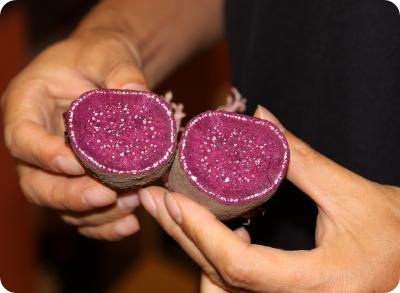Jun 30 2009
A Kansas State University researcher is studying the potential health benefits of a specially bred purple sweet potato because its dominant purple color results in an increased amount of anti-cancer components.
K-State's Soyoung Lim, doctoral student in human nutrition, Manhattan, is working with George Wang, associate professor of human nutrition at K-State, to understand the pigment effects of a Kansas-bred purple sweet potato on cancer prevention.
Lim said purple sweet potatoes have high contents of anthocyanin, which is a pigment that presents the purple color in the vegetable. The pigment can produce red, blue and purple colors depending on the source's chemical structure, such as in foods like blueberries, red grapes and red cabbage.
She said anthocyanins have been epidemiologically associated with a reduced cancer risk, but the anti-cancer ability of the purple sweet potato has not been well investigated.
Lim used a sweet potato with pronounced purple flesh and skin that was developed by K-State's Ted Carey, professor of horticulture, at K-State's John C. Pair Horticultural Center in Haysville.
"Sometimes we can find purple sweet potatoes in the grocery store, but they don't have this purple color on the skin and inside," Lim said.
Three different purple sweet potatoes were used that had varying amounts of anthocyanin for the project. To quantify the amount in each potato, Lim extracted pigments from the vegetables and injected them into an HPLC-MS Analysis, which she said is a method that separates components.
The potatoes were segregated by multiple traits based on flesh pigmentation and fiber contents. The analysis determined that the Kansas-bred potato had significantly higher anthocyanin contents compared to the other potatoes. The analysis also found two derivatives of anthocyanin that were dominant: cyanidin and peonidin, Lim said.
Lim also measured the potatoes' total phenolic content. Lim said phenols are chemical compounds that have been found to have anti-aging and antioxidant components. The specially bred purple sweet potato had a much higher total phenolic content and antioxidant capacity than the other regularly occurring purple sweet potatoes, she said.
The K-State researchers also wanted to see the specific effects of cyanidin and peonidin. Lim treated human colon cancer cells with low concentrations of the pigment derivatives and also studied the effects on the cell cycles.
Cyanidin and peonidin showed significant cell growth inhibition for the cancer cells, but there were no significant changes in the cell cycle. Lim said a better understanding of the underlying mechanisms in the Kansas-bred potato could provide scientific evidence of its health benefits.
Lim presented the research at the Experimental Biology Meeting in New Orleans in April. She is doing a follow-up study this summer that will involve treating animal cancer cells with the pigments.
Other contributors to the project include Takeo Iwamoto, research assistant professor of biochemistry at K-State; and K-State students Genna Gehrt, Alma, and Kacey Provenzano, Derby, both May 2009 bachelor's graduates in nutritional sciences.